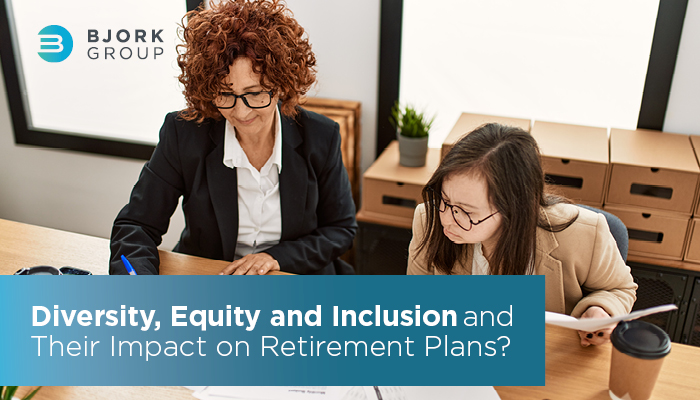Blog Article 3: Diversity, Equity and Inclusion and its Impact on Retirement Plans
- Bjork Group

Today’s workforce spans a variety of abilities, skills, experiences and cultural backgrounds that bring exceptional value. It is beneficial to understand and recognize these differences to achieve exceptional results. This remains true when offering, communicating and promoting your company’s retirement plan.
Raising Awareness
Thankfully, your retirement plan is no stranger to reporting. From participation rates, deferral percentages, asset allocation mixes, benchmarking analysis, investment reviews and other slice and dice metrics, retirement plan information is often shared based on your plan’s specific numbers and peer group comparison.
However, those calculations seldom include the lens of Diversity, Equity and Inclusion (DEI). Now all that is changing.
Expanding the Scope
Nearly two—thirds of plan sponsors have noticed an increased demand for retirement plans to align with DEI efforts. So, now is a good time for employers and retirement plan committee members to revisit and re—evaluate how their 401(k) plans align with the workplace climate.
Four primary areas to review your workplace retirement plan DEI may include:
- Participant cohorts: Participants save and accumulate assets differently. Take a look at your company’s demographics to spot under savers (participation, deferral, asset allocation, etc.). Then implement a targeted strategy to help all groups take advantage of the opportunities offered by your plan.
- Committee composition: To foster a deeper understanding of your employees’ savings experience, reassess and consider expanding the retirement plan committee to include a representative structure that mirrors your workforce, potentially bringing greater insights that enhance retirement savings.
- Investment offering: Consult with us for a review of your investment menu and discuss how a DEI strategy could be reflected throughout your retirement plan’s investment offerings.
- Holistic mindset: For the majority of Americans, the workplace retirement plan is their primary savings and accumulation vehicle for retirement. Employers and committee members should address the current financial state of plan participants to ensure the diverse needs of their workplace are being addressed. Boosting the financial wellbeing of plan participants can drive the improvement of plan outcomes and allow all demographic groups to better engage with the benefits offered to them.
Financial Wellness
DEI is an essential part of a financial wellness program. A financial wellness program’s purpose is to help employees improve their overall financial situation. The best way to do this is by gaining an understanding of the differences that may exist between diversity groups (e.g. age, race, ethnicity, gender, physical abilities, sexual orientation, etc.), followed by viewing plan data to identify cohorts that could benefit from receiving additional resources. Sponsors can also use the data presented to look at demographic groups and see if they have different engagement levels in the plan.
One idea to address participation gaps is auto—enrollment. It is agnostic across all employees; it has been found that when auto—enrollment is implemented with Black, Latinx and White Americans, the participation rate remains 80% across the board. Interestingly, when given the same auto—enrollment default, everyone saves the same when they have access. This is one example of how employers can address a coverage issue and, if applicable, address a racial disparity within 401(k) plan participation.
Financial Education
Diversity can extend not only to different cultural groups but varying generations as well. As such, employers should offer financial education resources that appeal to the different learning preferences (and languages) of each cohort along with best way to communicate with them about retirement, all while working to improve experiences through effective DEI.
As the lifestyles and stages of employees evolve, so do their financial needs and priorities. For a retirement program to be successful, employers should take these changes into consideration.
One size doesn’t fit all. Plan sponsors should seek to employ a mix of communications — utilizing brochures, emails, videos, infographics, blog articles and online calculators — to get the message out to different demographics within the plan.
Next Steps
To get started with your DEI strategy, consider these best practices:
- Know your employees: Seek to understand their differing demographics and assess participant behaviors from multiple perspectives.
- Talk with your service providers: Set up a meeting to learn what resources are readily available (e.g. financial wellness programs, plan data, different language options, etc.).
- Communicate with purpose: Your communications should highlight your retirement plan as a valuable benefit. Help your diverse workforce understand why it is important to save and how your company is helping to promote retirement preparedness.
Using DEI to guide plan decisions can help ensure your company’s retirement plan is working to positively impact the different cohorts of your employees. DEI used wisely can increase the retirement engagement and security of all.
Sean C. Bjork, CIMA®, AIF®
Vice President
Bjork Group
1033 Skokie Boulevard, Suite 210
Northbrook, IL. 60062
p.312.464.7082
seanbjork@bjorkgroup.com
www.bjorkgroup.com
Securities offered through LPL Financial, Member FINRA/SIPC. Investment advisory services offered through Global Retirement Partners, LLC, a registered investment advisor. Global Retirement Partners, LLC and Bjork Asset Management are separate entities from LPL Financial.
This information was developed as a general guide to educate plan sponsors and is not intended as authoritative guidance or tax/legal advice. Each plan has unique requirements, and you should consult your attorney or tax advisor for guidance on your specific situation.
©401(k) Marketing, LLC. All rights reserved. Proprietary and confidential. Do not copy or distribute outside original intent.


